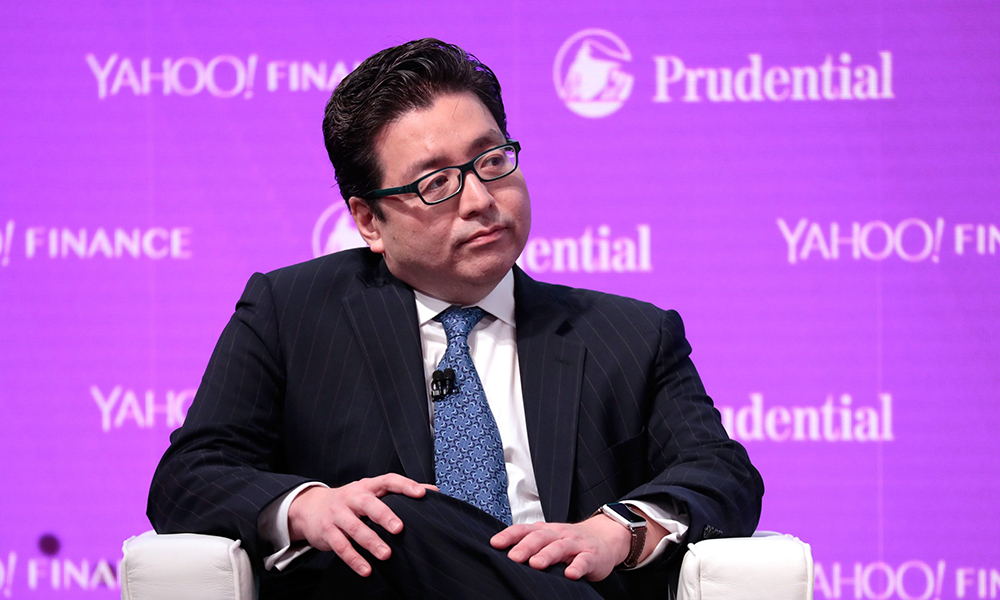
去年,有少部分人预测股市将大涨,Fundstrat Global Advisors联合创始人汤姆·李便是其中之一。当时,其大部分同僚认为,经济衰退预期大行其道,股市将大跌。
不过,他和美国经济证明,这些悲观论者是错误的。事实上,在彭博社(Bloomberg)调查的预测者当中,汤姆2023年的预测是最准确的。
今年,他再次做出预测,并得到了验证。6月初,他称标普500指数将在月底突破5500点大关。6月21日收盘时,标普500指数已经达到5464.62点。
如今,他进行了时间跨度更大的预测,令行业震惊:汤姆称,在2034年之前,标普500指数或将突破1.5万点大关,相当于超过170%的增幅。
在彭博社6月18日录制的最新一期《Odd Lots》播客节目中,他一开始便解释了自己的预测是有据可循的,即历史以及各类资产数据。他称,债券市场比股市更聪明:“这也是为什么人们说,股市是中等生的天堂。”
他还认为,投资者无法与美联储(Federal Reserve)抗衡,并将更多地关注推动增长的经济主题,例如:千禧一代如何重塑经济;全球劳动力短缺将提振人工智能和科技行业;以及能源安全和网络安全。汤姆称,通过选择每个主题的最优股,他自2019年以来年年都跑赢了大盘。
他还表示,华尔街往往会低估新科技的影响力,而最先采用这些科技的人群通常都是十几和二十几岁的年轻人,同时,大多数顶级投资专业人士都已40或50多岁。他还提到,手机在一开始并未受到富人重视,而是被当作玩具。人工智能当前的处境也是十分类似。
“人工智能的采用率异常之高,不过,考虑到劳动力短缺,用例十分重要,”汤姆说,“因此在我看来,我们很有可能低估了所有这些公司今后赚钱的能力。”
随着劳动力市场继续保持供不应求的状态,人工智能将变得愈发重要。他预计,到2034年,全球劳动力短缺数量将达到约4000万,相当于约3万亿美元的薪资支出。他解释说,考虑到大多数自动化都由半导体这类硬件支撑,这意味着这类芯片供应商或将拿到2万亿美元的收入。
汤姆表示,科技股最终将占到全球股市权重的40-50%,而当前为20%。
“在这个回归常态的世界中,如果这是一个与人口结构挂钩的正常标普周期,标普有望在10年之内达到1.5万点,稍后我可以用图表说明,”他说,“从更长的时间框架来看,我觉得市场很有可能正在朝这个方向迈进。”
股市已经严重向科技和人工智能股倾斜。今年,仅英伟达(Nvidia)一家公司便贡献了标普500超过三分之一的市值增量。与此同时,华尔街正努力迎合市场无节制的涨势,越来越多的分析师调高了其年终目标。
上述涨势和市场集中度让人们开始担心,人工智能热是其泡沫即将破灭的信号。然而,汤姆对这些顾虑毫不在意,并指出了人工智能与此前互联网等产业泡沫生灭之间的关键区别。
他表示,英伟达的竞争优势要比互联网热初期的思科(Cisco)深厚得多。他还指出,与网络泡沫不同的是,如今人工智能领域并没有出现过度炒作的IPO行为。
汤姆并非唯一一位做出大胆预测的华尔街看涨人士。爱德华·雅德尼一直对下一个“狂飙20年代”超级周期深信不疑,而且称标普500指数明年将跃升至6000点。
他称,到2034年,标普500指数可能会达到8000点,虽不及汤姆预测的高,但涨幅依然高达46%,着实不错。(财富中文网)
译者:冯丰
审校:夏林
去年,有少部分人预测股市将大涨,Fundstrat Global Advisors联合创始人汤姆·李便是其中之一。当时,其大部分同僚认为,经济衰退预期大行其道,股市将大跌。
不过,他和美国经济证明,这些悲观论者是错误的。事实上,在彭博社(Bloomberg)调查的预测者当中,汤姆2023年的预测是最准确的。
今年,他再次做出预测,并得到了验证。6月初,他称标普500指数将在月底突破5500点大关。6月21日收盘时,标普500指数已经达到5464.62点。
如今,他进行了时间跨度更大的预测,令行业震惊:汤姆称,在2034年之前,标普500指数或将突破1.5万点大关,相当于超过170%的增幅。
在彭博社6月18日录制的最新一期《Odd Lots》播客节目中,他一开始便解释了自己的预测是有据可循的,即历史以及各类资产数据。他称,债券市场比股市更聪明:“这也是为什么人们说,股市是中等生的天堂。”
他还认为,投资者无法与美联储(Federal Reserve)抗衡,并将更多地关注推动增长的经济主题,例如:千禧一代如何重塑经济;全球劳动力短缺将提振人工智能和科技行业;以及能源安全和网络安全。汤姆称,通过选择每个主题的最优股,他自2019年以来年年都跑赢了大盘。
他还表示,华尔街往往会低估新科技的影响力,而最先采用这些科技的人群通常都是十几和二十几岁的年轻人,同时,大多数顶级投资专业人士都已40或50多岁。他还提到,手机在一开始并未受到富人重视,而是被当作玩具。人工智能当前的处境也是十分类似。
“人工智能的采用率异常之高,不过,考虑到劳动力短缺,用例十分重要,”汤姆说,“因此在我看来,我们很有可能低估了所有这些公司今后赚钱的能力。”
随着劳动力市场继续保持供不应求的状态,人工智能将变得愈发重要。他预计,到2034年,全球劳动力短缺数量将达到约4000万,相当于约3万亿美元的薪资支出。他解释说,考虑到大多数自动化都由半导体这类硬件支撑,这意味着这类芯片供应商或将拿到2万亿美元的收入。
汤姆表示,科技股最终将占到全球股市权重的40-50%,而当前为20%。
“在这个回归常态的世界中,如果这是一个与人口结构挂钩的正常标普周期,标普有望在10年之内达到1.5万点,稍后我可以用图表说明,”他说,“从更长的时间框架来看,我觉得市场很有可能正在朝这个方向迈进。”
股市已经严重向科技和人工智能股倾斜。今年,仅英伟达(Nvidia)一家公司便贡献了标普500超过三分之一的市值增量。与此同时,华尔街正努力迎合市场无节制的涨势,越来越多的分析师调高了其年终目标。
上述涨势和市场集中度让人们开始担心,人工智能热是其泡沫即将破灭的信号。然而,汤姆对这些顾虑毫不在意,并指出了人工智能与此前互联网等产业泡沫生灭之间的关键区别。
他表示,英伟达的竞争优势要比互联网热初期的思科(Cisco)深厚得多。他还指出,与网络泡沫不同的是,如今人工智能领域并没有出现过度炒作的IPO行为。
汤姆并非唯一一位做出大胆预测的华尔街看涨人士。爱德华·雅德尼一直对下一个“狂飙20年代”超级周期深信不疑,而且称标普500指数明年将跃升至6000点。
他称,到2034年,标普500指数可能会达到8000点,虽不及汤姆预测的高,但涨幅依然高达46%,着实不错。(财富中文网)
译者:冯丰
审校:夏林
Fundstrat Global Advisors cofounder Tom Lee was among the few voices on Wall Street last year who predicted a stock market surge while most of his peers saw a slump amid widespread expectations for a recession.
But he—and the U.S. economy—proved the doomsayers wrong. In fact, among the forecasters surveyed by Bloomberg, Lee’s call in 2023 turned out to be the most accurate.
And this year, he’s still calling his shots and nailing them. In early June, he said the S&P 500 would hit 5,500 by the end of the month. As of Friday’s close, it was at 5,464.62.
Now, he’s got a longer-term forecast, and it’s a whopper: by the end of this decade, Lee said the S&P 500 could hit 15,000, representing upside of more than 170%.
On a recent episode of Bloomberg’s Odd Lots podcast, which was recorded on Tuesday, he began by explaining his evidence-based approach to forecasting, which looks across history and across assets. He said the bond market is smarter than the stock market: “That’s why they say equities are the land of C students.”
He also believes investors can’t fight the Federal Reserve and focuses more on themes that will drive growth, such as how millennials are reshaping the economy, the global labor shortage that will boost AI and tech stocks, as well as energy security and cybersecurity. By picking the strongest stocks within each theme, he has outperformed the market every year since 2019, Lee said.
Wall Street typically underestimates the impact of new technologies, which are usually adopted first by younger people in their teens and 20s while most top investment professionals are in their 40s and 50s, he added, noting that cell phones were initially dismissed as toys for the rich. Something similar is happening with AI.
“The adoption rate of AI is staggering, but the use case is important because there’s a labor shortage,” Lee said. “So to me, I think it’s very likely we’re underestimating how much revenue all these companies will make.”
And as the demand for workers continues to outstrip supply, AI will become more critical. By end of decade, he estimated the global labor shortage will be equivalent to 40 million workers, or about $3 trillion worth of wages. Considering that most of automation is from hardware like semiconductors, that means whoever is supplying the chips might have $2 trillion in revenue, he explained.
Eventually, technology will represent 40%-50% of global stock market weighting, up from about 20% today, Lee said.
“In a normalized world, if this is a normal S&P cycle following demographics, I could provide a chart later, S&P should be potentially 15,000 by the end of the decade,” he said. “As you move into longer timeframes, that’s probably where I think we’re moving towards.”
The stock market is already heavily concentrated on tech and AI stocks, with Nvidia alone accounting for more than a third of the S&P 500’s gains this year. Meanwhile, Wall Street is scrambling to keep up with the market’s relentless rally, with more analysts raising their year-end targets.
Such bullishness and market concentration have raised concerns that the AI hype is a sign of a bubble about to pop. But Lee downplayed those worries, pointing to key differences between earlier bubbles like the dot-com boom and bust.
He noted that Nvidia has a much steeper competitive advantage than Cisco did during the early stages of the internet boom. And unlike the dot-com bubble, there is a lack of overly hyped IPOs today, he added.
Lee isn’t the only Wall Street bull making bold predictions. Ed Yardeni has been pounding the table about another “Roaring 20s” super-cycle and has said the S&P 500 would jump to 6,000 by next year.
And by the end of the decade, he said the stock index could reach 8,000—not as high as Lee’s estimate but still good enough for a 46% jump.






